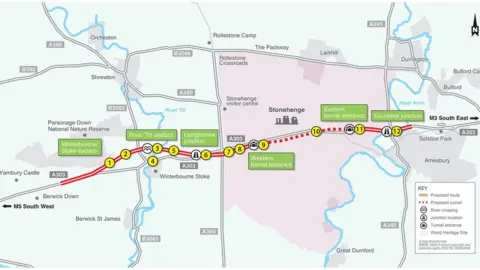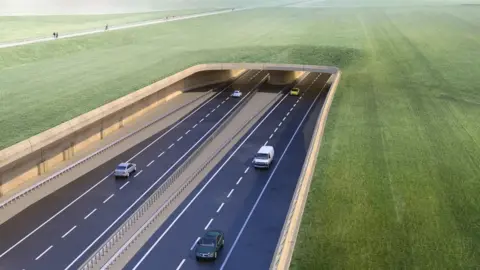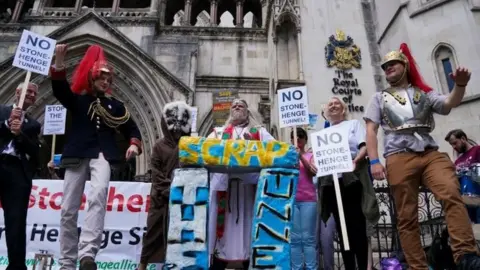Stonehenge tunnel: What does it mean for World Heritage Site?
 Getty Images
Getty ImagesJust a few days after hundreds gathered at Stonehenge for the summer solstice, the ancient monument is in the spotlight again, but this time over fears for its future.
A High Court challenge brought by campaigners is under way over the approval of a plan to build a tunnel near the World Heritage Site.
But what does it mean for the treasured iconic landmark and the area around it?
What is the plan?
Highways England wants to build a tunnel near Stonehenge as part of a £1.7bn project to improve traffic flows along the A303 in Wiltshire.
It is the most direct route for motorists travelling between the South East and South West and is used by thousands of people every day.
But traffic flows along an eight-mile (12.8km) single-carriageway section between Amesbury and Berwick Down are twice what the road was built for, according to the agency.
It wants to make 12 major improvements along the A303, including building a new bypass at Winterbourne Stoke and moving the junction between the A303 and A360 at Longbarrow.
The two-mile (3.2km) tunnel, which would be dug on the landscape of the A303, is the most contentious part of the project.
The agency says it will reduce traffic on the road and cut journey times.
 Highways England
Highways England Why do campaigners object?
Campaigners say the work will have a detrimental impact on the wider Stonehenge World Heritage Site, which surrounds the ancient stone circle.
It has been blasted a "complete violation" and "international scandal".
In December, Tom Holland, president of the Stonehenge Alliance group, said it was "hard to believe" the scheme had been given the go-ahead.
Some fear "devastation on a major scale" to the landscape.
Not everyone is opposed, though. Wiltshire Council's cabinet formally supported the scheme in January.
Its then leader, Philip Whitehead, said he saw it as a solution to "horrendous" traffic in villages on or to close to the A303.
 Getty Images
Getty ImagesWhy is the site significant?
Stonehenge is one of the world's most famous prehistoric monuments. Its first part was built about 5,000 years ago and its stone circle was placed there in the late Neolithic period, in about 2500 BC.
The site, together with Avebury, also in Wiltshire, was declared a World Heritage Site in 1986 on account of the size of the megaliths, the sophistication of their concentric plans and the complexes of Neolithic and Bronze Age sites and monuments.
Before Covid, many people would gather at the site to celebrate the summer solstice - hundreds did so on Monday, despite official advice not to.
 Highways England
Highways England What is the judicial review about?
At the end of 2020, Save Stonehenge World Heritage Site (SSWHS) raised the £50,000 it needed to bring a judicial review at the High Court.
It argues Transport Secretary Grant Shapps did not properly consider the damage that would be done to a number of prehistoric sites and ancient artefacts, and that his approach to the World Heritage Convention was unlawful.
John Adams, a director of SSWHS, said on Wednesday: "This is crucial, this might be our last opportunity to stop this road going through the [site]."
The case will not judge the merits of the tunnel or the scheme but only if Mr Shapps acted unlawfully in approving it.
The project is classified as nationally significant, which means a development consent order from the transport secretary is needed for it to go ahead.
 PA Media
PA MediaWhat happens next?
The High Court challenge, before Mr Justice Holgate, is expected to last until the end of the week.
Highways England said the tunnel plan will remove the sight and sound of traffic passing the site and without any further delays building should begin in 2023.
It will hold a public Q&A meeting on the A303 scheme on 29 June.

Follow BBC West on Facebook, Twitter and Instagram. Send your story ideas to: [email protected]
